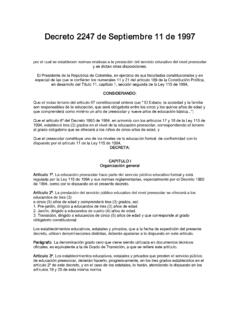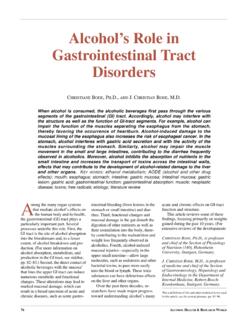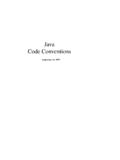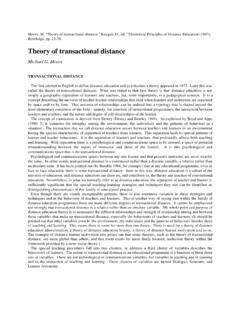Transcription of DRAM Technology - Smithsonian Institution
1 OVERVIEWDRAM (Dynamic Random Access Memory) is the main memory used for all desktop and largercomputers. Each elementary DRAM cell is made up of a single MOS transistor and a storagecapacitor (Figure 7-1). Each storage cell contains one bit of information. This charge, however,leaks off the capacitor due to the sub-threshold current of the cell transistor. Therefore, the chargemust be refreshed several times each second. HOW THE DEVICE WORKSThe memory cell is written to by placing a 1 or 0 charge into the capacitor cell. This is doneduring a write cycle by opening the cell transistor (gate to power supply or VCC) and presentingeither VCCor 0V (ground) at the capacitor. The word line (gate of the transistor) is then held atground to isolate the capacitor charge. This capacitor will be accessed for either a new write, aread, or a 7-2 shows a simplified DRAM diagram. The gates of the memory cells are tied to therows.
2 The read (or write) of a DRAM is done in two main steps as illustrated in Figure 7-3. Therow (X) and column (Y) addresses are presented on the same pads and multiplexed. The firststep consists of validating the row addresses and the second step consists of validating thecolumn CIRCUIT ENGINEERING CORPORATION7-17 DRAM TECHNOLOGYWord LineBit LineTransistorCapacitorPlateSource: ICE, "Memory 1997 "19941 Figure 7-1. DRAM CellDRAM TechnologyINTEGRATED CIRCUITENGINEERING CORPORATION7-2 DataDataSenseAmplifierDataDataSenseAmpli fierDataDataSenseAmplifierDataDataSenseA mplifierOutputBufferDoutY DecodeCASYXRASA ddressPadsRow DecodeSource: ICE, "Memory 1997 "22430 DinInputBufferFigure 7-2. Simplified DRAM DiagramFigure 7-3. DRAM Access TimingStep IRow AccessStep IIColumn AccessRowColumnAddressRASCASS ource: ICE, "Memory 1997 "22431 First Step: Row AddressesRow addresses are present on address pads and are internally validated by the RAS (Row AddressAccess) clock.
3 Abar on top of the signal name means this signal is active when it is at a low X addresses select one row through the row decode, while all the other non-selected rowsremain at 0V. Each cell of the selected row is tied to a sense amplifier. Asense amplifier is a cir-cuit that is able to recognize if a charge has been loaded into the capacitor of the memory cell, andto translate this charge or lack of charge into a 1 or 0. There are as many sense amplifiers as thereare cells on a row. Each sense amplifier is connected to a column (Yaddress). In this first step allthe cells of the entire row are read by the sense amplifier. This step is long and critical because therow has a high time constant due to the fact that it is formed by the gates of the memory , the sense amplifier has to read a very weak charge (approximately 30 femtoFarads or 30fF). Second Step: Column AddressesFollowing the first step, column addresses are present on the address pads and are internally val-idated by the Column Address Access (CAS) clock.
4 Each selected memory cell has its data vali-dated in a sense amplifier. Column access is fast. This step consists of transferring data presentin the sense amplifier to the Doutpin through the column decode and the output buffer. Onmemory data sheets, the access time from RAS is termed tRACand the access time from CAS islisted as tCAC. On a typical standard DRAM of 60ns access time, tRAC= 60ns and tCAC= maintain data integrity, it is necessary to refresh each DRAM memory cell. Each row of cellsis refreshed every cycle. For example, if the product specification states, Refresh cycle = 512cycles per 8ms, then there are 512 rows and each individual row must be refreshed every explained above, during the row access step, all the cells from the same row are read by thesense amplifier. The sense amplifier has two roles. Since it holds information within the cell, it isable to transmit this data to the output buffer if it is selected by the column address.
5 The senseamplifier is also able to re-transmit (write) the information into the memory cell. In this case, it refreshes the memory cell. When one row is selected, all the cells of that row are read by thesense amplifiers and all these cells are refreshed one at a time. Burst or distributed refresh methods can be used. Burst refresh is done by performing a series ofrefresh cycles until all rows have been accessed. For the example given above, this is done every8ms. During the refresh, other commands are not allowed. Using the distributed method andthe above example, a refresh is done every s (8ms divided by 512). Figure 7-4 shows thesetwo TechnologyINTEGRATED CIRCUITENGINEERING CORPORATION7-3 For standard DRAMs there are three ways to perform refresh cycles. They are RAS-only refresh,CAS-before-RAS refresh, and hidden refresh. To perform a RAS-only refresh, a row address is puton the address lines and then RAS goes low.
6 To perform a CAS-before-RAS refresh, CAS first goeslow and then a refresh cycle is performed each time RAS goes low. To perform a hidden refreshthe user does a read or write cycle and then brings RAS high and then CELLA great deal of design effort has been made to shrink the cell area, particularly, the size of theDRAM capacitor. As memory density increases, the cell size must decrease. Designers have man-aged to shrink overall cell size. However, due to factors such as noise sensitivity and speed, it hasbeen a challenge to reduce the capacitance. The capacitance must stay in the range of charge (Q) stored in a capacitor is equal to capacitance times voltage (Q = C x V). Over theyears, DRAM operating voltage has decreased ( , 12V to 5V to ). As voltage decreases, thestored charge will also decrease. Design improvements allow for the decrease in the cell chargeas long as the capacitance remains in the range of main developments are used to reduce capacitor area without reducing its value.
7 These arethe use of new capacitor shapes to fit into a minimum chip surface area and increasing thedielectric Cell ShapeThe 1 Mbit DRAM generation was the first to abandon the classical planar capacitor and replace itwith a trench or a stacked capacitor. Figure 7-5 shows the feature sizes of some of the DRAM devices that ICE analyzed in its laboratory these two last years. Trench capacitors are not widelyused in spite of continual research and development on that type of design. As shown, the major64 Mbit DRAMs available on the market are today made of stacked capacitors. DRAM TechnologyINTEGRATED CIRCUITENGINEERING CORPORATION7-4 DistributedRefreshBurstRefreshEach Pulse Representsa Refresh CycleTimeRequired Time ToComplete Refresh Of All RowsSource: Micron, "Memory 1997 "20843 Figure 7-4. Burst and Distributed RefreshCross sections of 64 Mbit DRAMs analyzed by ICE s laboratory illustrate three major choices formanufacturing DRAM memory cells.
8 Hitachi uses a stacked, multi-layer capacitor for its 64 MbitDRAM (Figure 7-6). The trench capacitor (Figure 7-7) is used by IBM/Siemens, and the simplestack capacitor (Figure 7-8, and 7-9) is preferred by Samsung and NEC. Figure 7-10 shows how size cell improvements will be necessary for the next DRAM 7-11 illustrates the stacked capacitor structure evolution. The decrease of cell size withoutdecreasing capacitor value results in increasing complexity of memory cell Technology . Most lead-ing DRAM manufacturers are working on 1 Gbit cells. Their goal is to decrease the size of the cellwithout compromising the value of the capacitor. Two types of 1 Gbit cell developments are shown in the next figures. Toshiba tried to improve thetrench capacitor concept by creating a bottle-shape trench design (Figure 7-12). Hitachi tried toimprove the stack concept with a vertical and circular capacitor (Figure 7-13).
9 NEC received apatent from the Patent Office for its proprietary HSG (hemispherical-grain) silicon TechnologyINTEGRATED CIRCUITENGINEERING CORPORATION7-5 Source: ICE, "Memory 1997 "22432 FujitsuMosel- CodeCell Area m2 Die Areamm2 Gate LengthCell TypeNameFigure 7-5. Physical Dimensions of DRAMsFigure 7-6. Hitachi 64 Mbit DRAM Cross SectionPhoto by ICE, Memory 1997 19814 DRAM TechnologyINTEGRATED CIRCUIT ENGINEERING CORPORATION7-6 POLY 5 CAPACITOR SHEETPOLY 4 CAPACITORPLATENITRIDEETCH-STOPLAYER STEM POLY 2 BITCONTACT PADPOLY 2 BIT LINECONTACTREFLOW GLASSN+ S/DPOLYCIDE 1 SELECT GATEP hoto by ICE, Memory 1997 20844 Figure 7-8. Samsung 64 Mbit DRAM Cross SectionPhoto by ICE, Memory 1997 22433 METAL 1 METAL 2 METAL 3 POLY 1 TRENCHCAPACITORSF igure 7-7. IBM/Siemens 64 Mbit DRAM Cross SectionPhoto by ICE, Memory 1997 22434 CAPACITORDIELECTRICPOLY 4 CAPACITOR SHEETPOLY 3 CAPACITORPLATEPOLY 2 BIT LINEPOLY 3 STEM Figure 7-9. NEC 64 Mbit DRAM Cross SectionCAPACITOR DIELECTRICSThe inability to scale the capacitor value has led to the consideration of new dielectric materials forthe capacitor.
10 It is likely that materials with higher dielectrics will see more use. Many of the mate-rials have proven track records through their use as dielectrics in discrete capacitors. Therefore, themain challenge is the introduction of these materials into the IC process. Figure 7-14 shows someof the materials under consideration. Tantalum Pentoxide (Ta2O5) has been viewed in several ofthe 64 Mbit DRAMs analyzed by the ICE laboratory. Ta2O5seems that it could serve as a gooddielectric since it can easily be integrated into conventional stack capacitor structure. However, itrequires higher dielectric thickness, resulting in only a marginal improvement in capacitance. PERFORMANCEC ompared with other memory ICs, DRAMs suffer from a speed problem. The on-chip circuitryrequired to read the data from each cell is inherently slow. As such, DRAM speeds have not keptpace with the increased clock speed of TechnologyINTEGRATED CIRCUITENGINEERING Generation (bits)Chip Area (mm2), Cell Area ( m2)Minimum Feature Size ( m2)Source: Hitachi/ICE, "Memory 1997 "20775 ACell AreaChip AreaMinimumFeature SizeFigure 7-10.











